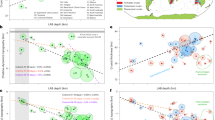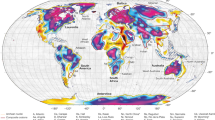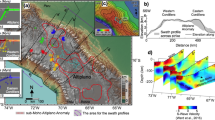Abstract
Stable continental cratons are the oldest geologic features on the planet. They have survived 3.8 to 2.5 billion years of Earth’s evolution1,2. The key to the preservation of cratons lies in their strong and thick lithospheric roots, which are neutrally or positively buoyant with respect to surrounding mantle3,4. Most of these Archaean-aged cratonic roots are thought to have remained stable since their formation and to be too viscous to be affected by mantle convection2,3,5. Here we use a combination of gravity, topography, crustal structure and seismic tomography data to show that the deepest part of the craton root beneath the North American Superior Province has shifted about 850 km to the west–southwest relative to the centre of the craton. We use numerical model simulations to show that this shift could have been caused by basal drag induced by mantle flow, implying that mantle flow can alter craton structure. Our observations contradict the conventional view of cratons as static, non-evolving geologic features. We conclude that there could be significant interaction between deep continental roots and the convecting mantle.
This is a preview of subscription content, access via your institution
Access options
Subscribe to this journal
Receive 12 print issues and online access
$259.00 per year
only $21.58 per issue
Buy this article
- Purchase on Springer Link
- Instant access to full article PDF
Prices may be subject to local taxes which are calculated during checkout



Similar content being viewed by others
References
Yuan, H. & Romanowicz, B. Lithospheric layering in the North American Craton. Nature 466, 1063–1068 (2010).
Lee, C.-T. A., Luffi, P. & Chin, E. J. Building and destroying continental mantle. Annu. Rev. Earth Planet. Sci. 39, 59–90 (2011).
Carlson, R. W., Pearson, D. G. & James, D. E. Physical chemical, and chronological characteristics of continental mantle. Rev. Geophys. 43, RG1001 (2005).
Eaton, D. W. & Perry, H. K. C. Ephemeral isopycnicity of cratonic mantle keels. Nature Geosci. 6, 967–970 (2013).
Pearson, D. G., Carlson, R. W., Shirley, S. B., Boyd, F. R. & Nixon, P. H. Stabilization of Archean lithospheric mantle: A Re–Os isotopic study of peridotite xenoliths from the Kaapvaal Craton. Earth Planet. Sci. Lett. 134, 341–357 (1995).
Goes, S. & van der Lee, S. Thermal structure of the North American uppermost mantle inferred from seismic tomography. J. Geophys. Res. 107, ETG 2-1–ETG 2-13 (2002).
Bokelmann, G. H. R. Convection-driven motion of the North American Craton: Evidence from P-wave anisotropy. Geophys. J. Int. 148, 278–287 (2002).
Eaton, D. W. & Frederiksen, A. Seismic evidence for convection-driven motion of the North American plate. Nature 446, 428–431 (2007).
Mooney, W. D. & Kaban, M. K. The North American upper mantle: Density, composition, and evolution. J. Geophys. Res. 115, B12424 (2010).
Petrunin, A. G., Kaban, M. K., Rogozhina, I. & Trubitsyn, V. Revising the spectral method as applied to modeling mantle dynamics. Geochem. Geophys. Geosyst. 14, 3691–3702 (2013).
Sella, G. F., Dixon, T. H. & Mao, A. REVEL a model for recent plate velocities from space geodesy. J. Geophys. Res. 107, ETG 11-1–ETG 11-30 (2002).
Conrad, C. P. & Lithgow-Bertelloni, C. Influence of continental roots and asthenosphere on plate-mantle coupling. Geophys. Res. Lett. 33, L05312 (2006).
Yoshida, M. Temporal evolution of the stress state in a supercontinent during mantle reorganization. Geophys. J. Int. 180, 1–22 (2010).
Heaman, L. M., Kjarsgaard, B. A. & Creaser, R. A. The timing of kimberlite magmatism in North America: Implications for global kimberlite genesis and diamond exploration. Lithos 71, 153–184 (2003).
Calais, E., Han, J. Y., DeMets, C. & Nocquet, J. M. Deformation of the North American plate interior from a decade of continuous GPS measurements. J. Geophys. Res. 111, B06402 (2006).
Steinberger, B. & O’Connell, R. J. Advection of plumes in mantle flow: Implications for hotspot motion, mantle viscosity and plume distribution. Geophys. J. Int. 132, 412–434 (1998).
Obrebski, M., Allen, R. M., Pollitz, F. & Hung, S.-H. Lithosphere–asthenosphere interaction beneath the western United States from the joint inversion of body-wave traveltimes and surface-wave phase velocities. Geophys. J. Int. 185, 1003–1021 (2011).
Artemieva, I. M. & Mooney, W. D. Thermal thickness and evolution of Precambrian lithosphere: A global study. J. Geophys. Res. 106, 16387–16414 (2001).
Jones, A. G. et al. Electric lithosphere of the Slave Craton. Geology 29, 423–426 (2001).
Eaton, D. W. et al. The elusive lithosphere–asthenosphere boundary beneath cratons. Lithos 109, 1–22 (2009).
Poudjom Djomani, Y. H., O’Reilly, S. Y., Griffn, W. L. & Morgan, P. The density structure of subcontinental lithosphere through time. Earth Planet. Sci. Lett. 184, 605–621 (2001).
Griffin, W. L., Andi, Z., O’Reilly, S. Y. & Ryan, C. G. Phanerozoic evolution of the lithosphere beneath the Sino-Korean Craton. Mantle Dyn. Plate Interact. East Asia 27, 107–126 (1998).
Cooper, C. M. & Conrad, C. P. Does the mantle control the maximum thickness of cratons? Lithosphere 1, 67–72 (2009).
Lenardic, A. & Moresi, L.-N. Some thoughts on the stability of cratonic lithosphere: Effects of buoyancy and viscosity. J. Geophys. Res. 104, 12747–12758 (1999).
Ritsema, J., Deuss, A., van Heijst, H. J. & Woodhouse, J. H. S40RTS: A degree-40 shear-velocity model for the mantle from new Rayleigh wave dispersion, teleseismic traveltime and normal-mode splitting function measurements. Geophys. J. Int. 184, 1223–1236 (2011).
Van der Lee, S. & Nolet, G. Upper mantle S velocity structure of North America. J. Geophys. Res. 102, 22815–22838 (1998).
Forte, A. M. & Peltier, R. Viscous flow models of global geophysical observables: 1. Forward problems. J. Geophys. Res. 96, 20131–20159 (1991).
Steinberger, B. & Calderwood, A. R. Models of large-scale viscous flow in the Earth’s mantle with constraints from mineral physics and surface observations. Geophys. J. Int. 167, 1461–1481 (2006).
Kaban, M. K., Petrunin, A. G., Schmeling, H. & Shahraki, M. Effect of decoupling of lithospheric plates on the observed geoid. Surv. Geophys. 35, 1361–1373 (2014).
Hayes, G. P., Wald, D. J. & Johnson, R. L. Slab1.0: A three-dimensional model of global subduction zone geometries. J. Geophys. Res. 117, B01302 (2012).
Acknowledgements
This study was partly supported by the German Research Foundation (DFG, Grant PE2167/1-1) and the US Geological Survey.
Author information
Authors and Affiliations
Contributions
M.K.K. conceived the study and carried out the gravity data analysis and construction of the 3D density model. A.G.P. conducted the geodynamic modelling. M.K.K., W.D.M. and A.G.P. contributed to interpretation of the results and conclusions. M.K.K. and W.D.M. wrote the manuscript.
Corresponding author
Ethics declarations
Competing interests
The authors declare no competing financial interests.
Supplementary information
Supplementary Information
Supplementary Information (PDF 1361 kb)
Rights and permissions
About this article
Cite this article
Kaban, M., Mooney, W. & Petrunin, A. Cratonic root beneath North America shifted by basal drag from the convecting mantle. Nature Geosci 8, 797–800 (2015). https://doi.org/10.1038/ngeo2525
Received:
Accepted:
Published:
Issue Date:
DOI: https://doi.org/10.1038/ngeo2525
This article is cited by
-
The Global Crust and Mantle Gravity Disturbances and Their Implications on Mantle Structure and Dynamics
Surveys in Geophysics (2024)
-
A New Moho Map for North-Eastern Eurasia Based on the Analysis of Various Geophysical Data
Pure and Applied Geophysics (2022)
-
Modification of the Western Gondwana craton by plume–lithosphere interaction
Nature Geoscience (2018)
-
3-D Upper-Mantle Shear Velocity Model Beneath the Contiguous United States Based on Broadband Surface Wave from Ambient Seismic Noise
Pure and Applied Geophysics (2018)



